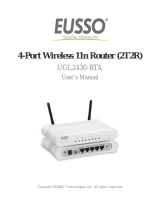
- I -
CONTENTS
Package Contents..................................................................................................................................1
Chapter 1. Introduction.......................................................................................................................2
1.1 Overview of the Router .......................................................................................................2
1.2 Conventions ........................................................................................................................3
1.3 Main Features .....................................................................................................................3
1.4 Panel Layout .......................................................................................................................4
Chapter 2. Connecting the Router .....................................................................................................5
2.1 System Requirements.........................................................................................................5
2.2 Installation Environment Requirements ..............................................................................5
2.3 Connecting the Router ........................................................................................................5
Chapter 3. Quick Installation Guide................................................................................................ 10
3.1 TCP/IP Configuration ....................................................................................................... 10
3.2 Quick Installation Guide................................................................................................... 12
Chapter 4. Configuration for AP Mode ........................................................................................... 28
4.1 Login ................................................................................................................................ 28
4.2 Status ............................................................................................................................... 28
4.3 Quick Setup...................................................................................................................... 30
4.4 Working Mode.................................................................................................................. 30
4.5 Network............................................................................................................................ 31
4.6 Wireless ........................................................................................................................... 32
4.7 DHCP............................................................................................................................... 41
4.8 System Tools.................................................................................................................... 44
Chapter 5. Configuration for Router Mode .................................................................................... 51
5.1 Login ................................................................................................................................ 51
5.2 Status ............................................................................................................................... 51
5.3 Quick Setup...................................................................................................................... 54
5.4 Working Mode.................................................................................................................. 54
5.5 Network............................................................................................................................ 55
5.6 Wireless ........................................................................................................................... 64
5.7 DHCP............................................................................................................................... 74
5.8 Forwarding ....................................................................................................................... 77
5.9 Security ............................................................................................................................ 83
5.10 Static Routing................................................................................................................... 91
5.11 IP QoS.............................................................................................................................. 92




















